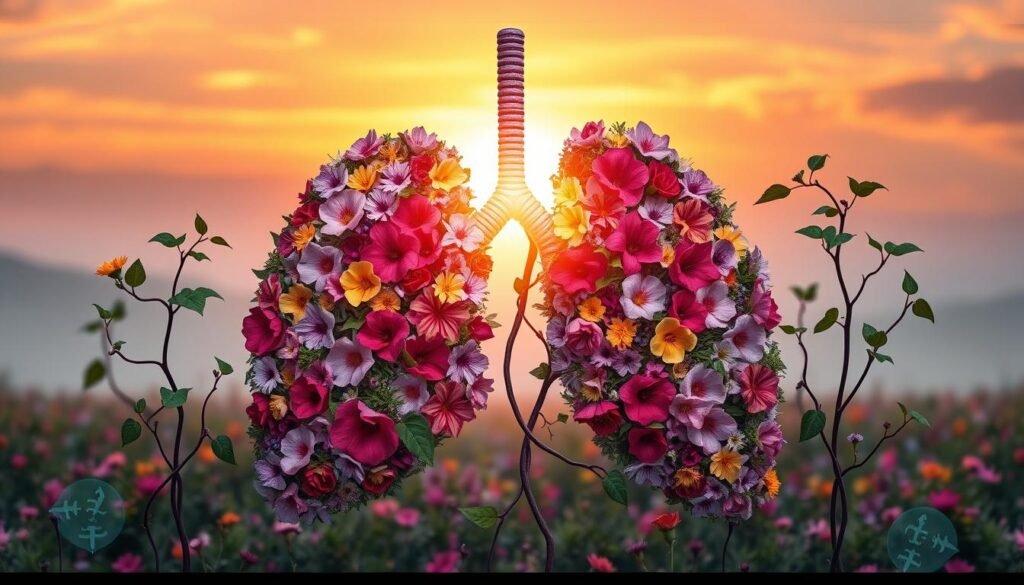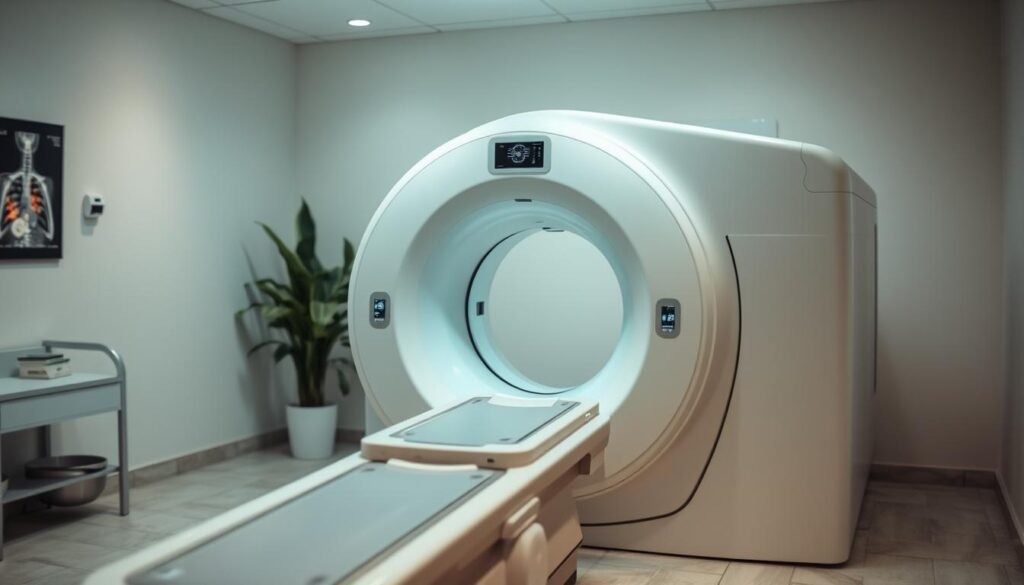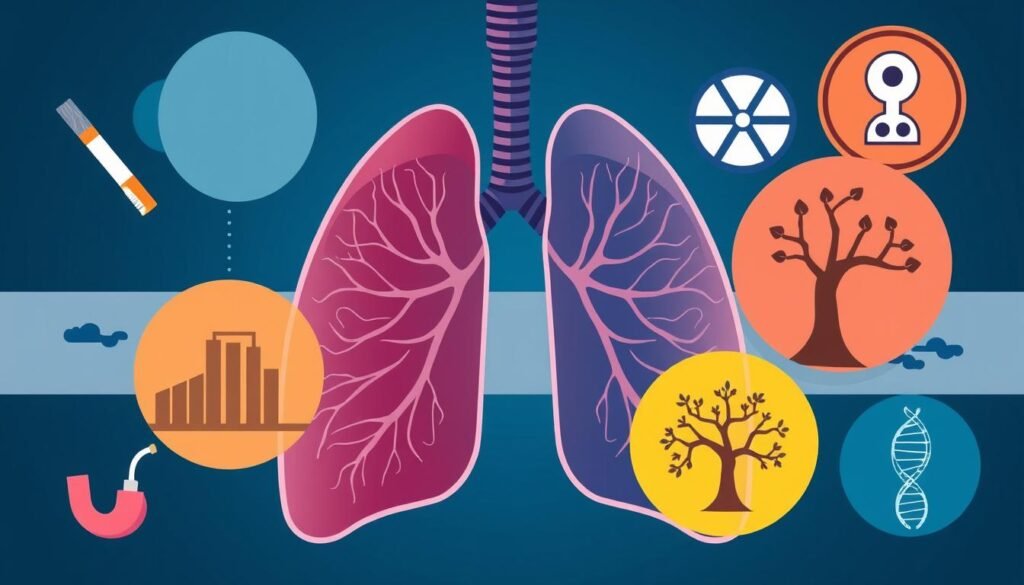Did you know that more than 65% of people with stage I lung cancer can live for at least five years after finding out they have it? This amazing fact shows how important early detection and treatment are for lung cancer. With around 238,000 new cases expected in the U.S. this year, knowing the survival rate for early stage lung cancer is key for patients and their families.
Stage I lung cancer gives patients a better chance of survival compared to more advanced stages. If caught early, the cure rate can jump to 80%-90%. But, not everyone has the same chances of survival. For example, patients of color often have worse outcomes than white patients. Yet, in the past two years, there’s been a 17% improvement in survival rates for people of color.
Only 26.6% of lung cancer is found early, making it clear how critical it is to know the symptoms and get regular screenings. Massachusetts is doing the best in the country with an 11.9% screening rate. But the nationwide rate is only 4.5% as of 2022. Early detection is crucial for a better chance of survival.
Key Takeaways
- More than 65% of individuals diagnosed with stage I lung cancer survive for at least five years.
- The cure rate for stage I lung cancer can reach 80%-90% with early intervention.
- Only 26.6% of lung cancer cases are diagnosed early, emphasizing the need for awareness.
- Regular screenings play a critical role in improving lung cancer survival rates.
- Patients of color continue to face disparities in lung cancer outcomes.
Understanding Lung Cancer Stages
Lung cancer has different types, each with unique traits and survival chances. Knowing the stages of lung cancer is key for choosing the right treatment and predicting the future. We’ll look at the two main types of lung cancer and why staging is so important for both checking the condition and figuring out the outlook.
Overview of Lung Cancer Types
Lung cancer splits into two main kinds: non-small cell lung cancer (NSCLC) and small cell lung cancer (SCLC). NSCLC is the most common, making up about 80–85% of all cases. SCLC is rarer, at 10–15% of cases, but it’s very aggressive.
Importance of Staging in Prognosis
The stage of lung cancer is crucial for knowing survival chances and deciding on treatment. The TNM system checks the cancer by looking at tumor size, lymph node involvement, and if it has spread. The stage when diagnosed makes a big difference in survival rates; localized cases have a 62.8% chance of surviving five years, but this drops to about 8% with distant spread.
For non-small cell lung cancer, survival rates fall dramatically through the stages, down to 5% at stage 4. Catching the disease early and pinpointing its stage helps in finding the best way to treat it and can lead to a better outcome.
What is Early Stage Lung Cancer?
Early stage lung cancer is often called stage 1. This is when the cancer is just in the lungs. It hasn’t spread to nearby lymph nodes or other organs. Knowing what stage 1 lung cancer means is vital. It can change the way doctors treat it and the patient’s future.
Definition of Stage 1 Lung Cancer
Stage 1 lung cancer is split into stages 1A and 1B. These stages are based on how big the tumor is and where it’s located:
- Stage 1A: The tumor is less than 3 centimeters and hasn’t moved outside the lung.
- Stage 1B: The tumor is between 3 to 5 centimeters. It may have spread to nearby areas but not to the lymph nodes.
This way of grouping the cancer is key. It helps doctors figure out the best treatment and what the patient can expect.
Types of Early Stage Lung Cancer
Early stage lung cancer types mainly fall into two groups. Most belong to non-small cell lung cancer (NSCLC). A few are small cell lung cancer (SCLC). NSCLC is more common and includes these kinds:
- Adenocarcinoma: Usually found in the outer parts of the lung.
- Large Cell Carcinoma: It grows quickly and can be anywhere in the lung.
- Squamous Cell Carcinoma: It starts in the lining of the airways.
SCLC is rarer and is split into limited and extensive stages. These stages show how much the cancer has spread inside the lungs and beyond. Picking out the exact type of lung cancer is crucial. It helps doctors create the best plan to treat it.
| Stage | Sub-Stage | Tumor Size | Lymph Node Involvement |
|---|---|---|---|
| 1 | A | Less than 3 cm | No |
| 1 | B | 3 to 5 cm | No |
| 2 | A | Varies | Possible |
Early Stage Lung Cancer Survival Rate
The survival rate for early stage lung cancer shows how patients might do after diagnosis. It’s crucial for patients and their families to understand this. It helps them choose the right treatment.
Five-Year Survival Statistics for Non-Small Cell Lung Cancer
For non-small cell lung cancer, the five-year survival rates are hopeful, especially in early stages. Stage IA1 has a high survival rate of 92%. Stage IA2’s survival rate is 83%.
For stage IB, the rate falls to 68%. This shows why finding cancer early is key. Over 65% of those found with stage I lung cancer live for five years or more. If found early, up to 80%-90% can be cured with the right treatment.
Comparison with Small Cell Lung Cancer
Small cell lung cancer, however, has a much lower survival rate at about 5.6%. This highlights its aggressive nature compared to non-small cell lung cancer. Understanding the type of lung cancer early is critical. Early detection is very important for better health outcomes.
Those with small cell lung cancer face bigger survival challenges than those with non-small types. For more info on these statistics, click here.
Factors Influencing Lung Cancer Survival Rates
Lung cancer survival rates can be complex. Factors like tumor location, size, patient’s age, and cancer type are critical. Healthcare providers use this info to plan the best treatments.
Role of Tumor Location and Size
Where the tumor is and how big it is matters a lot. Big tumors or those blocking airflow lead to worse outcomes. The impact of tumor size on survival can’t be overlooked. It significantly influences the choice of treatment and survival chances.
Patients with smaller, localized tumors often live longer. They have better five-year survival rates than those with advanced diseases.
Impact of Age on Survival Rates
Age greatly influences lung cancer survival. People younger than 50 have a five-year survival rate of 83.7%. But those over 65 see their rates drop to about 54.6%. This shows how crucial age is in lung cancer outcomes.
Cancer Type and Its Effects on Prognosis
The type of lung cancer plays a big role in prognosis. Adenocarcinoma patients usually do better than those with squamous cell carcinoma. Recognizing these differences helps doctors create more personalized treatments. It’s key for setting patient expectations and improving treatment decisions, impacting life quality and survival.
Treatment Options for Early Stage Lung Cancer
When treating early stage lung cancer, surgery is usually the first step. It is important to look at how effective the surgery will be for each patient. This consideration depends on the type of cancer and its size.
Surgery: Types and Effectiveness
A common surgery for non-small cell lung cancer (NSCLC) is a lobectomy. This surgery removes a lung lobe that contains the tumor. Other options include wedge resection and pneumonectomy. The choice of surgery is based on the tumor’s features and the patient’s health status. Surgery at the earliest stage is crucial for the best outcomes. Studies show a 70% five-year survival rate for stage I NSCLC treated with surgery.
Adjuvant Chemotherapy and Radiation
If surgery alone might not be enough, doctors may add adjuvant chemotherapy. This is especially true for stage II and IIIA NSCLC patients. It aids in targeting any cancer cells left. Radiation therapy can also support surgery in advanced cases. This approach increases the chances of a positive result. Treatment plans tailor to each patient’s situation, ensuring the best chance for longer survival. By using surgery, chemotherapy, and radiation together, the treatment becomes more effective for each patient.
Lung Cancer Screening and Early Detection
Early detection can greatly help lung cancer patients live longer. Regular screenings find the disease early, when it’s easier to treat. This is key to improving patients’ health.
Importance of Regular Screenings
Studies show early diagnosis of lung cancer boosts survival rates. For example, low-dose CT screenings show an 80% survival after 20 years. That’s impressive compared to the overall five-year survival rate of 18.6%.
This low rate exists because only 16% of lung cancers are caught early. Regular screenings are essential for early discovery. Many people don’t see symptoms until it’s too late.
Common Screening Tests for Lung Cancer
Low-dose CT is the best screening method for those at high risk. This includes long-term smokers aged 50 to 80. Despite its effectiveness, less than 6% of those eligible get screened.
The U.S. Preventive Services Task Force urges yearly screenings for these adults. Early detection through these screenings can save lives.

Lung Cancer Symptoms to Watch For
Noticing lung cancer symptoms early is key for better treatment results. People need to know the main signs that might mean trouble. Quick action can greatly boost the success of treatments.
Common Indicators of Early Stage Lung Cancer
Some symptoms may point to early lung cancer. These include:
- A persistent cough that gets worse.
- Coughing up blood or blood-streaked mucus.
- Shortness of breath and trouble breathing.
- Chest pain that stays or gets worse with deep breaths.
- Unexplained weight loss and tiredness.
Don’t overlook these symptoms. Even if they seem minor, they can be a big deal in the early stages.
When to Seek Medical Attention
If you notice any of these common signs, see a doctor right away. Early checks can lead to early detection and more effective treatments. Starting treatment early greatly improves the odds of beating the disease.
Lung Cancer Risk Factors
Lung cancer risk factors are key in understanding how to prevent this disease. They are split into two types: modifiable and non-modifiable. Modifiable risk factors, like smoking and being around certain toxins, greatly affect lung cancer risk. Non-modifiable factors, such as your genes, age, and past lung diseases, can’t be changed.
Modifiable vs. Non-Modifiable Risk Factors
Distinguishing between modifiable and non-modifiable risk factors helps in fighting lung cancer. Smokers or those exposed to second-hand smoke have a higher risk. Quitting smoking can greatly benefit one’s health and lower lung cancer chances. Other changeable factors are diet, exercise, and avoiding toxic substances at work or home.
The Impact of Smoking on Survival Rates
Smoking is the top cause of lung cancer. Research reveals that current smokers with early lung cancer have a low five-year survival rate of 33%. Meanwhile, those who stop smoking before or during treatment often survive longer. This shows how crucial it is to quit smoking for better health and treatment success.

| Stage of Lung Cancer | Five-Year Survival Rate | Smoking Effects |
|---|---|---|
| Localized | 65% (Non-Small Cell) | 33% (Current Smokers) |
| Regional | 37% (Non-Small Cell) | Lower Survival Rates |
| Distant | 9% (Non-Small Cell) | Substantially Reduced |
| All Stages Combined | 28% (Non-Small Cell) | Negative Impact |
| Localized | 30% (Small Cell) | 33% (Current Smokers) |
| Regional | 18% (Small Cell) | Lower Survival Rates |
| Distant | 3% (Small Cell) | Substantially Reduced |
| All Stages Combined | 7% (Small Cell) | Negative Impact |
Current Research on Lung Cancer Prognosis
Ongoing research is changing how we treat lung cancer. New treatments are being developed. These are more focused and effective. This has greatly improved survival chances for patients. Studies continue to look at trends and data. They aim to better understand lung cancer survival rates.
Advancements in Treatment Approaches
We’re seeing new therapies that are more personal. These are designed based on the cancer’s unique molecular makeup. Immunotherapies and targeted treatments help patients live longer, with better quality of life. Early detection through advanced screening is key for the best outcomes.
Trends in Lung Cancer Survival Rates Over Time
In the past five years, lung cancer survival rates in the U.S. have increased. The five-year survival rate has gone up by 26%, to 28.4%. This is thanks to better awareness, improved screening, and new treatments. Low-dose CT scans have been shown to significantly reduce deaths from lung cancer. They can lower the death rate by up to 20%.
However, rates of screening differ widely across the country. Rhode Island leads with 28.6%, while Wyoming is at 8.6%. This shows the need for more screening everywhere.
But only 16.0% of those who should get screened did so last year. More screenings could add 500,000 years of life and save $500 million. Continuous research and health efforts are vital to reach these goals. And to improve lung cancer outcomes for everyone.
| Stage | 5-Year Survival Rate |
|---|---|
| Stage 1 | 65% |
| Stage 2 | 40% |
| Stage 3 | 15% |
| Stage 4 | 5% |
| Overall (All Stages) | 23% |
Support and Resources for Lung Cancer Patients
Lung cancer patients need a mix of emotional and practical support. It helps them deal with their diagnosis and treatment. This support is key to finding comfort and guidance during tough times.
Emotional and Practical Support Options
Emotionally supporting lung cancer patients is crucial for their well-being. Counseling and therapy provide safe spaces to express feelings. Support groups allow patients to share their stories and reduce loneliness. Groups like CancerCare host free sessions for patients and caregivers, guided by experts. This builds emotional strength for facing treatment.
Help with practical matters is just as important. Patients often face financial challenges with treatment costs. CancerCare offers financial aid for qualifying individuals. They also provide help to navigate resources, so patients can concentrate on getting better. Services like Magnolia Meals at Home deliver healthy meals to families dealing with cancer, stressing good nutrition during treatment.
Connecting with Support Groups
Joining support groups helps lung cancer patients find a sense of community. These groups share coping tips and offer support, whether they meet online or in person. CancerCare’s workshops also give access to expert advice, enhancing patient knowledge.
One-on-one mentoring gives personalized emotional support. It fosters a bond between those who have faced similar challenges. Tools like Connect booklets and fact sheets help manage side effects and learn about treatments. They empower patients to better handle their illness.
Conclusion
Knowing about early stage lung cancer survival rates is key for patients and their loved ones. Thanks to new treatments and early detection, people with stage 1 lung cancer have a better outlook. For example, the five-year survival rate for stage 1a1 non-small cell lung cancer (NSCLC) is up to 92%.
It’s crucial to catch lung cancer early through regular screenings and recognizing symptoms. Quitting smoking also greatly improves your chances of survival. In fact, people who stop smoking when they start treatment can see their survival rates jump to 70%.
Being informed about lung cancer can lead to better outcomes. Going for screenings, understanding treatment options, and making healthy life choices can make a big difference. Every effort to detect and treat lung cancer early can help save lives.